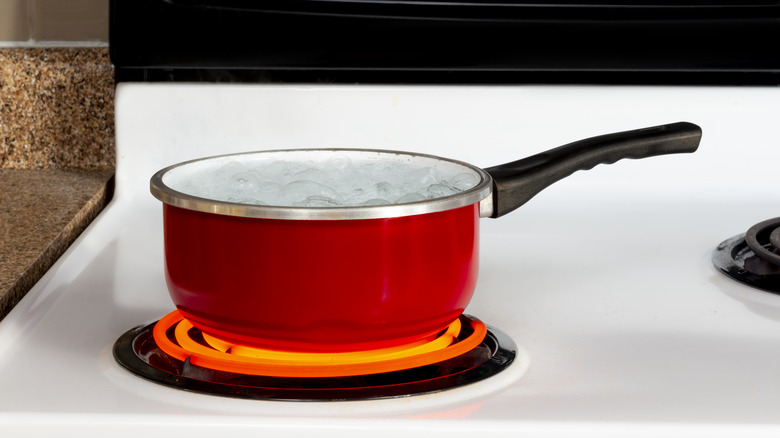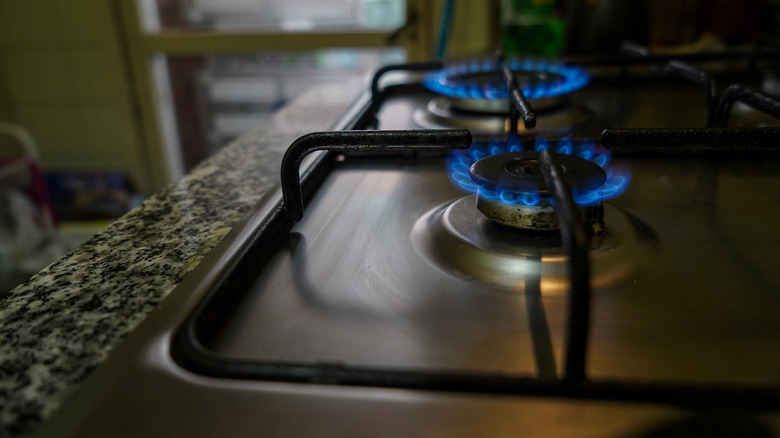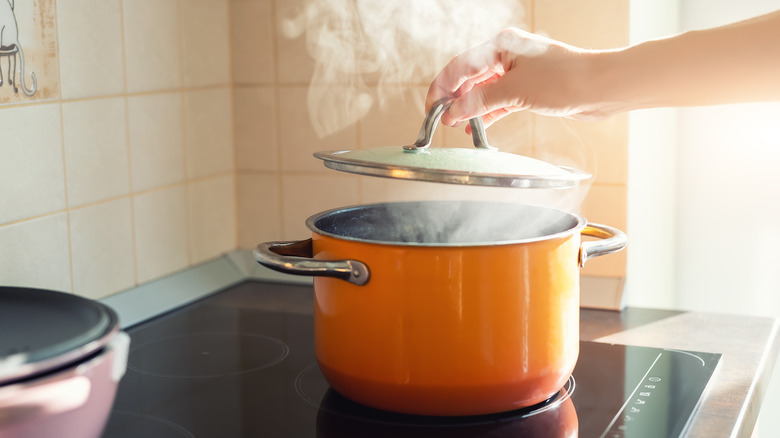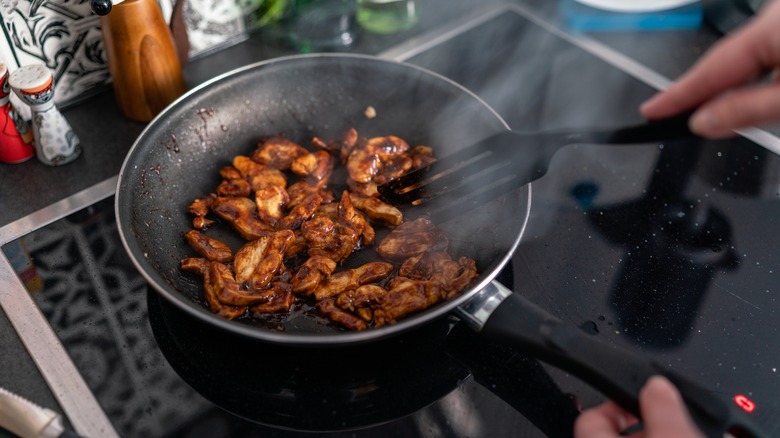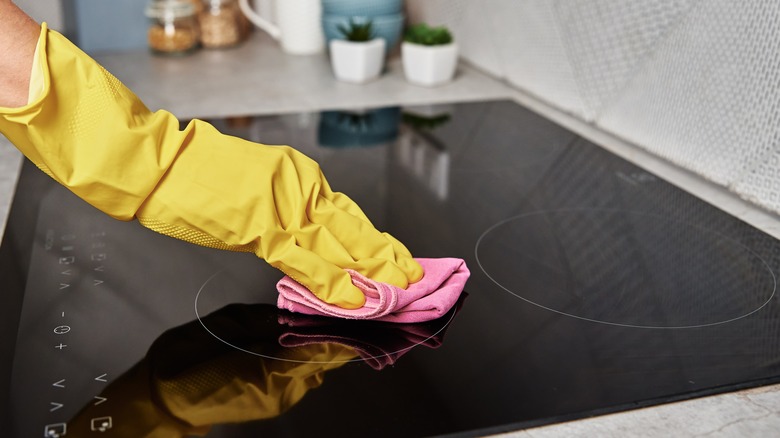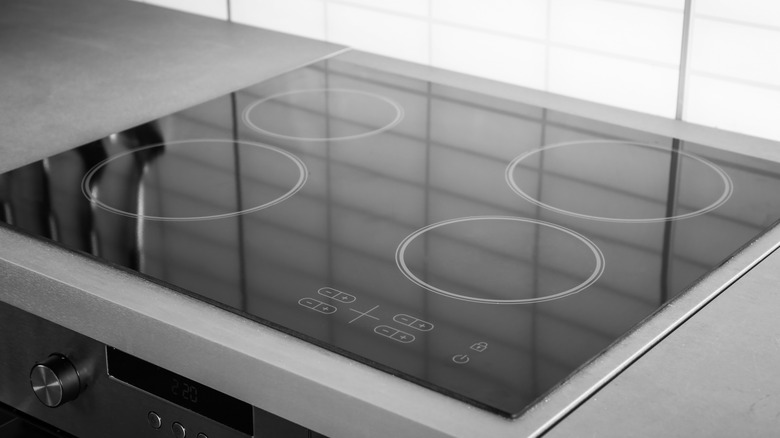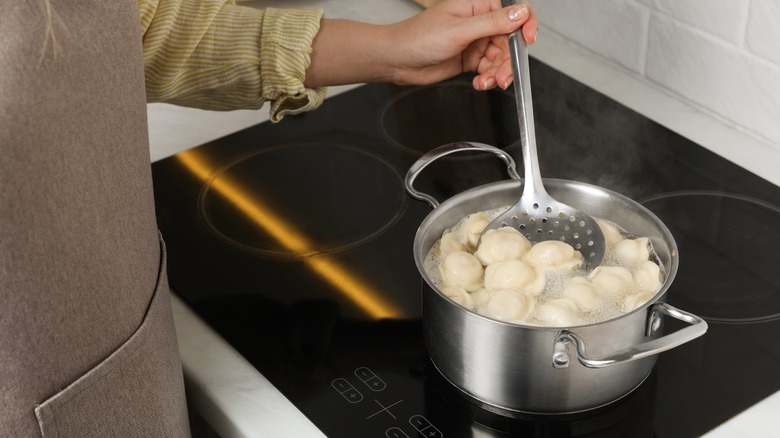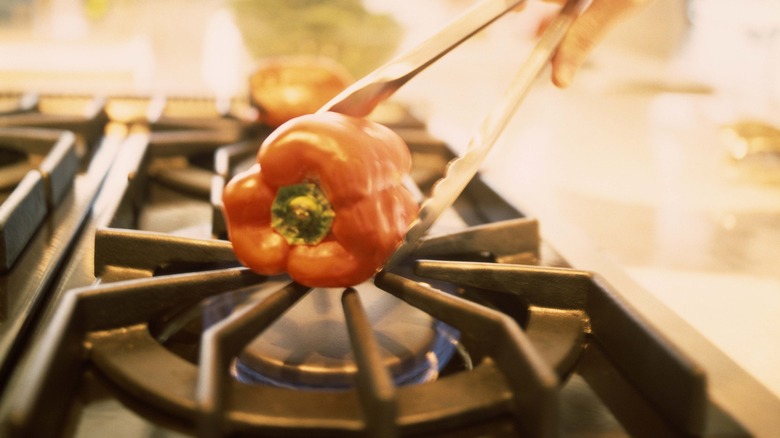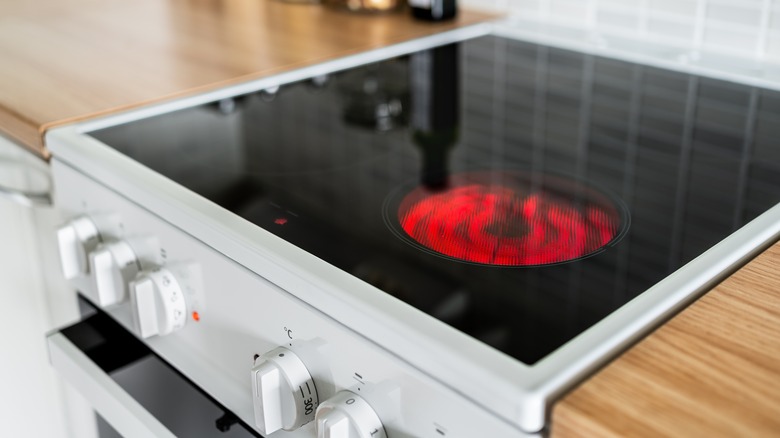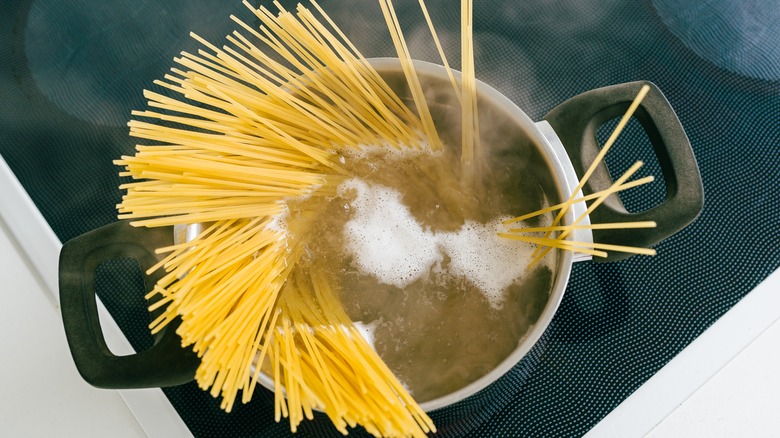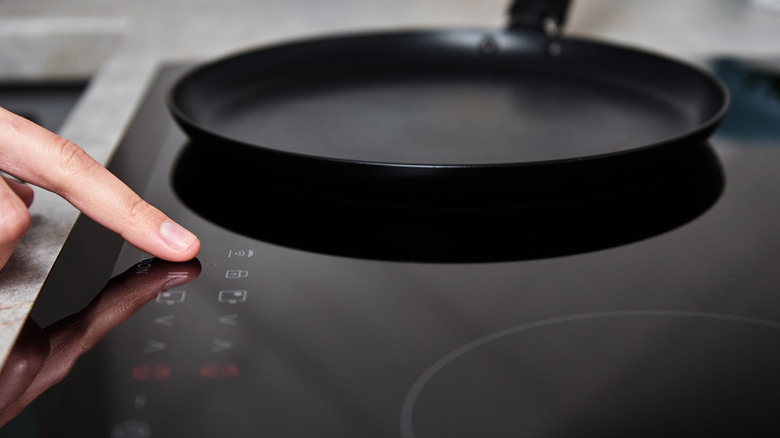Here's How To Master The Switch From A Gas To An Electric Stove
Bureaucrats and lawmakers alike are debating whether to ban gas stoves, per The Washington Post, prompting many home cooks to envision a world without them. The latest argument comes on the heels of studies indicating gas stoves may be harmful to both human health and the environment. In fact, your gas stove is probably leaking methane into your house right now — and this is more than a mere puff of smoke. The methane released by gas stoves every year from all U.S. homes — both when stoves are in use and when they're off — is nearly equivalent to 500,000 cars' worth of emissions (per a Stanford University study).
More than 40 million U.S. homes own a gas stove, according to that 2022 study. And although talks of a possible ban on new gas stoves have taken on more prominence, the debate between gas and electric stovetops has raged for years. Many have already ditched their gas stovetop for an electric version.
While it's yet to be seen whether anyone will actually be forced to swap out appliances, some may do so of their own volition. Others may have to adapt to an electric stovetop if, for example, they're moving to a new home or cooking dinner in someone else's kitchen. Whatever the reason may be for the swap, there's a catalogue of details worth knowing when it comes to transitioning from one source to another. Here's how to master the switch from a gas to an electric stovetop.
A glance at the process of switching from gas to electric
Although most American homes already use an electric stove, many of them were built to accommodate the appliance. If you've switched from a gas to an electric stove, you know that the transition isn't impossible, but it can be costly and potentially interrupt home cooking for a short period of time. If you do make the switch, it's wise to have a plan that includes a timeframe and a realistic cost expectation to make the process go more smoothly.
As for the process, there are several important steps to take before setting an installation date. As noted by Make the Switch, you first need to ensure your electric box has a high enough amperage for an electric stovetop. This will determine whether your home is compatible as is or if you need an electrician to install new circuitry to support the stovetop. After that, choose your stovetop and schedule a gas expert and an electrician to install the appliance. The actual installation shouldn't take more than a couple hours.
The other major factor to consider when switching from a gas to an electric stovetop is the cost. Per Fixr, plan to spend anywhere from $500-$1,000 on the installation and at least that same amount if not more on the appliance itself. Ask for labor quotes, look for budget stovetops, and see about a federal rebate for making the switch to potentially lower your cost (via The New York Times).
You'll have to adjust to the time difference
Once your electric stovetop is installed, the real work begins. There are several adjustments you'll have to make when cooking with an electric stove if you're far more used to using a gas stove, or if you've never used one before. As you probably know, gas stovetops use a flame to conduct heat while electric stovetops use electricity. This difference in heating method makes cooking with each appliance unique, particularly in the time it takes to heat a pan or reduce the temperature, as noted by KitchenAid. With an open flame, heat comes instantly. On an electric stovetop, it takes a few minutes for pans to heat up, which can require a bit of an adjustment for cooks who are used to using gas.
There are ways to make up for this time difference, though. Be foresighted in your preparation and use the extra time to prepare sides or chop vegetables. Keeping lids on pots and pans while cooking can also help speed up the heating process. Cooking might be a little different at first, but the ease and comfort you felt with your old gas stovetop will soon return. And when you view the adjustment as a new challenge in your cooking skill, it becomes fun and exciting rather than a shock to the system. As one cook pointed out in The Washington Post, trust yourself in your kitchen and don't get too caught up in technicalities.
You may need some new cookware
The price of a new stovetop and the installation fee aren't the only costs you'll incur when transitioning from your old gas stovetop to a new electric appliance. You may also need to purchase new pots and pans. This likely won't be the case for everyone who makes the switch, but make sure you examine your current set of cookware to ensure the materials are compatible with your new cooktop.
Per Urdesign, stainless-steel, cast-iron, and carbon-steel cookware will all work just fine on an electric stovetop. Materials to avoid include glass and ceramic. Note that flat-bottom cookware will work the best on electric stovetops as they'll have the most even heat distribution. And if you're a wok lover, rest assured you can use your wok on your electric stovetop, but know that a flat-bottomed wok will work best.
Though there are some pieces of cookware you can't use on an electric stovetop, there are also some pieces you just won't want to use. Some electric stovetops are made with burners that can be removed from the appliance, but others have a smooth glass top. You might find that some pots and pans scratch your smooth glass top, and some cookware might be too big for your burners. Spend some time in the kitchen getting to know your cooktop, and do what works best for you.
Here's how to clean your electric stove
Along with your new stovetop will come new maintenance methods. For most people, cooking is far more fun than cleaning, but it's important to keep a clean workspace, and that includes your stovetop. As Philip Tierno Jr., Ph.D., noted to NBC, "Splatters or spills of food that aren't promptly cleaned up can become a good medium for the growth of microbes." To avoid turning your stovetop into the ideal environment for a science experiment, Tierno suggests cleaning your stovetop after each use and cleaning the front of your range weekly.
If you're new to using an electric stove, fear not, because cleaning it isn't too tough, especially if you have a glass top. The most important aspect of the change in cleaning is ensuring you're using the right cleaning materials and tools that won't damage it. As cleaning expert Hugo Guerrero told House Digest, wait until your stovetop has completely cooled. "Wipe down the surface with a soft damp cloth to remove any loose dirt or debris. Mix a solution of equal parts water and vinegar in a spray bottle. Spray the solution onto the surface of the stove and let it sit for a few minutes," he said. "Use a soft, non-abrasive sponge or cloth to scrub the surface of the stove in a circular motion," then wipe the stovetop dry to avoid streaks. As Proline Range Hoods reminds us, if your stovetop has removable burners, take them out before cleaning.
Everything you need to know about burners
Another learning curve that comes with using an electric stovetop vs. a gas one is the difference in burners. Because heat comes from electricity, the entire burner will be hot to the touch. If you're not careful, this can result in injury. Since there won't be a visible flame to indicate the burner isn't safe to touch, get yourself in the habit of waving your hand over the surface to detect heat, using the backside rather than your palm as it's more sensitive to temperature, per this medical study. Note, too, that the burners will turn red when on, so look for that color change.
It'll also serve you well to become familiar with troubleshooting your burner. Per Prime Appliance Repairs, if your burner isn't turning on, there could be several reasons, most of which are associated with the electricity source. If you're comfortable, you can troubleshoot some problems with your burner on your own, but if you suspect there's a major issue preventing your burners from heating up, call an electrician.
Be sure to understand how your new burners work, too. Know how to turn them on and off, and realize that they'll take longer to heat up and cool down compared with gas burners. Also note that, per GE, electric burners cycle on and off, but you probably won't notice. Also be sure you read your stovetop's manual to ensure you know any nuances to your particular burners.
Tips to speed things up
We suspect you'll find the transition from using a gas stovetop to an electric stovetop to be mostly painless (once your bank account recovers, that is). But there may be some lingering peccadilloes that don't diminish over time due to the nature of the appliance. For instance, electric cooktops will always take longer to heat up than gas cooktops. Not even a Michelin Star-rated or James Beard Award-winning chef can change that. But what they and you can do is find ways to speed things up, making the entire cooking process quick and painless.
One tip is to utilize a separate electric kettle if you're boiling water. Electric kettles boil water quickly, and they're perfect to use if you're making tea or instant coffee. But they can also be used if you're boiling water for pasta or noodles. The kettle will get your water boiling faster than your stovetop, saving you some time in the kitchen. In the spirit of saving time, you can also utilize your oven to preheat pots and pans. It's important to have hot pots and pans before you start cooking, and if you're short on time, stick them in the oven to preheat before moving your cookware to your stovetop.
Here's how to char food on an electric stove
Though every chef is different, it's commonly thought that most prefer a gas cooktop to an electric one. Many like the speed at which gas cooktops heat up as well as the ease of controlling the temperature that comes with one, but there are plenty of other reasons they prefer it, like getting a char on their food. With a gas stove, cooks have the ability to place their food directly on the open flame, resulting in a lovely char that many of us are used to having only at a restaurant or around a bonfire. But having an electric stovetop doesn't mean you have to say goodbye to your deliciously charred food.
To get that char on an electric stovetop, make sure the burner is on high heat, wait until it's turned red, then put your food directly on top of the burner. If you'd like, you can set a BBQ rack on top of your burner first, but you don't have to. Some recipes claim the char won't be any different from that of an open flame. Others have accepted that it might not be the same as what they once tasted from their gas stove. The outcome will certainly vary on preferences and techniques, but don't think you've lost the possibility of charring food completely just because you have a new stove.
Try using two burners at once
As you familiarize yourself with your new cooktop, you'll likely amass your own tips and tricks for efficiency and success in the kitchen, but it's nice to start with some advance knowledge, too. One you might like is using two burners at once. Many chefs love to use a gas cooktop because it's easy to control the temperature. The flame instantly reacts to a change in direction, making it simple to move from high heat to medium-low heat or vice versa in seconds. With an electric stovetop, that can be a little trickier since it takes longer for the temperature to adjust. And when you find yourself cooking something that requires a quick, major change in temperature, you can ruin your food if you don't have a proper technique.
Solve this issue by using two burners at once. Keep one burner on high heat and another on low. When it's time to turn down the heat, simply move your cookware from the hotter burner to the cooler burner. This will allow you to easily change the cooking temperature without affecting the outcome of your meal.
This approach can be a little risky, though. It requires leaving an open, hot burner, so make sure you're standing by to ensure nothing comes in contact with the burner while it's on. Also be sure to let others in your home know you're cooking, and teach them, especially children, how to know whether an electric burner is on.
Avoid using high heat unless you're boiling water
Electric cooktops have three basic settings: low, medium, and high (they may also be numerical). These settings indicate how fast the burner will heat up and the frequency at which the burner is going to cycle on and off. The higher the setting, the less the burner going to cycle off in order to maintain the temperature. Because of this, it's highly important that you do not leave any food unattended while cooking on high on an electric stovetop. It's a major fire hazard that could result in serious injury or damage to your kitchen, your tools, and the appliance. You probably should avoid using high heat all together, unless you're boiling water or another liquid.
Many of us cook the way we use instruction manuals — we either read the entire recipe prior to starting and refer back to it as we cook, or we use it as a reference at best. If you follow recipes with fidelity, you'll probably notice that most don't direct you to use high stovetop settings. But if you cook according to intuition (which is completely fine), you possibly picked up an only-using-the-high-setting habit along the way. If so, break it now and reserve that setting for boiling. Aside from the potential hazard it presents to your space and belongings, the high setting may also result in food that's unevenly cooked. No one wants a fire, but no one wants bad food, either.
Consider an induction cooktop
If you're making the switch from a gas cooktop to an electric cooktop, you have two options — traditional electric or induction. An induction cooktop is a type of electric stove that uses magnetism to heat, making the cookware a part of the heating process, as noted by Heins Appliance. Many cooks are huge fans of induction cooktops because they are energy efficient, they're safer, and they heat more quickly than traditional electric options. They're also easy to clean and pretty simple to use, so they're worth considering if you have to get a new stovetop anyway.
There are some things to consider before hopping aboard the induction train, though, as The Washington Post points out. For instance, you'll have to secure cookware that is compatible with induction. Because it uses magnetism to heat, your cookware needs to be magnetic. You also might have to adjust some of your cooking methods and techniques, like the time it takes for the temperature to change, as it's very quick. However, as mentioned, there are lots of positives to an induction cooktop (like the truly insane phenomenon that means water will be boiling in less than two minutes). If you're going to get a new appliance, purchase new cookware, and change parts of your cooking style anyway, it's worth at least considering induction over traditional electric.
